COVID-19 Forecast Models Report for Arizona, January 15 Update
Note this forecast page is not the most recent forecast available.
View the most current forecast report
Researcher Analyzes Arizona COVID-19 Spread Models for Decision-Makers
The following information regarding the spread of COVID-19 in Arizona was prepared by Joe Gerald, MD, PhD, a researcher at the Mel and Enid Zuckerman College of Public Health (MEZCOPH) at the University of Arizona. This information has also been reviewed by other MEZCOPH faculty.
This data were obtained from the Arizona Department of Health Services COVID-19 webpage and reflect conditions in Arizona as of January 15, 2021.
This information is intended to help guide our response to the outbreak. It is not intended to predict how this pandemic will evolve. Rather, this model extrapolates what might occur if current conditions remain unchanged. As regional authorities and healthcare providers respond, their actions are expected to mitigate the worst consequences of this pandemic.

COVID-19 Disease Outbreak Forecast
Arizona State and Pima County
Updated January 15, 2021
Disclaimer: This information represents my personal views and not those of The University of Arizona, the Zuckerman College of Public Health, or any other government entity. Any opinions, forecasts, or recommendations should be considered in conjunction with other corroborating and conflicting data. Updates can be accessed at https://publichealth.arizona.edu/news/2021/covid-19-forecast-model.
**NOTICE** Arizona remains in a public health crisis where access to critical care services is limited due to shortages of space, personnel, and critical supplies. These conditions will persist into February. Additional mitigation efforts are needed to slow the pace of viral transmission and ease the burden on hospitals and allow ongoing vaccination efforts to reach the most vulnerable.
For the week ending January 10th, at least 60283 new Covid-19 cases were diagnosed in Arizona (Figure 1). This is a 7% increase from last week’s initial tally of 56108 and a new record. Last week’s tally was upwardly revised by 4% (2122 cases) this week to 58230 cases. Test capacity and/or uptake continues to rebound from the holiday period reaching a new high of 212728 individuals tested for Covid-19. For the first time in many weeks, test positivity declined, dropping from 35% last week to 33% the week ending January 10th. This indicates that viral transmission is now growing slower than testing capacity is increasing.
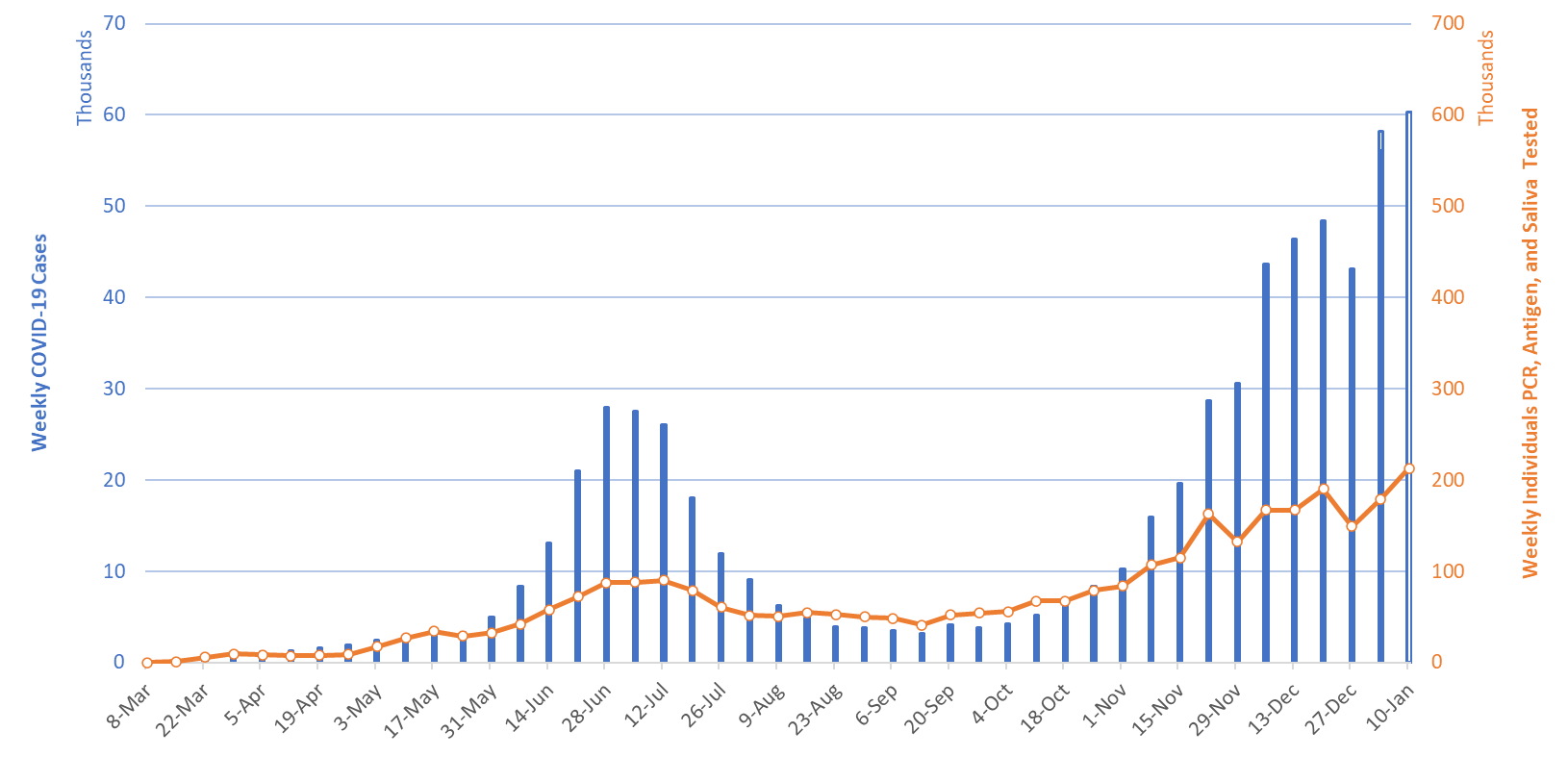
|
Figure 1. Newly Diagnosed Covid-19 Cases in Arizona and Number of Individuals Undergoing Covid-19 Diagnostic Testing March 1 through January 10, 2021. |
Nevertheless, testing capacity remains woefully inadequate to the scale of the problem. The outbreak remains broadly entrenched across all age groups (Figure 2).
Note: Data for this report was updated Friday, January 15 allowing 4 full days to adjudicate cases and keep week-over-week backfill 10%. This allows more interpretable comparisons and graphics. All comparisons are week-over-week changes. Future updates will be released on Saturdays.

|
Figure 2. Newly Diagnosed Covid-19 Cases in Arizona by Age Group March 1 through January 10, 2021. |
Test positivity among those undergoing traditional nasopharyngeal PCR testing decreased from 35% the week ending January 3rd to 33% the week ending January 10th (Figure 3). The decline in positivity indicates that viral transmission is growing slower than testing capacity is increasing. Nevertheless, 33% positivity reflects a woefully inadequate testing capacity as positivity should be less than 5 – 10%.
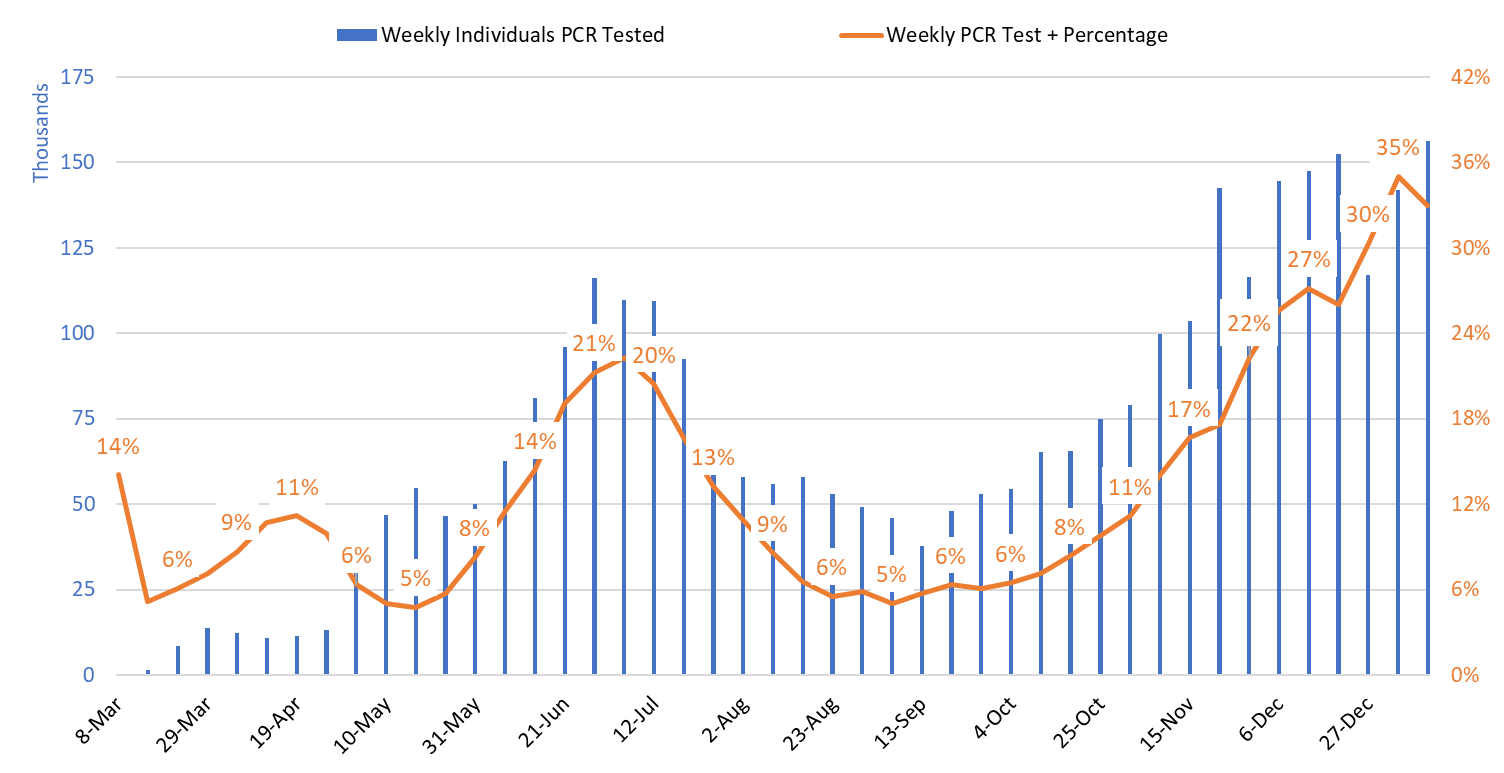
|
Figure 3. Weekly Number Patients Undergoing Traditional Nasopharyngeal PCR Testing and Associated Percent Positivity March 1 – January 10, 2021. |
As of Jan 15th, 4849 (56%) of Arizona’s 8664 general ward beds were occupied by Covid-19 patients, a 1% decrease from the previous week’s 4907 occupied beds (Figure 4 and Figure 5 Panel A). Another 656 (8%) beds remained available for use. The number of available beds is higher than the previous week’s 618 beds.
At 4849 beds and 56% occupancy, Arizona has seen the first, albeit small, week-over-week decline in Covid-19 patients and percent occupancy in several months. While still incredibly high, the change is welcomed.
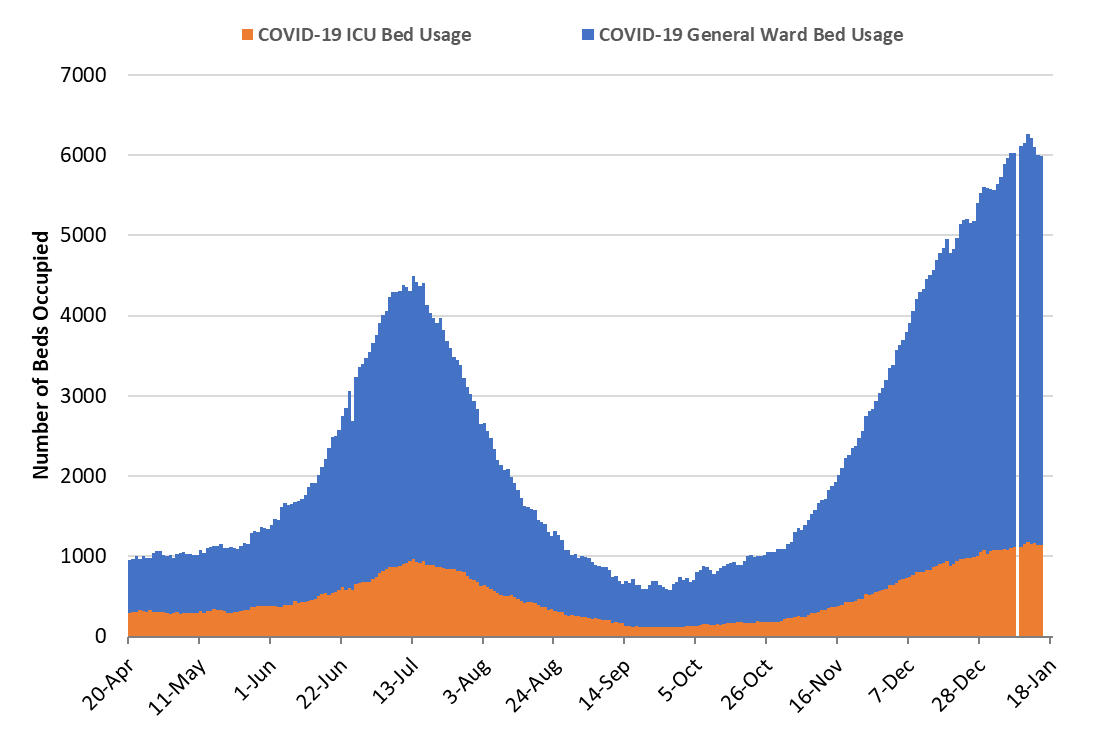
|
Figure 4. Arizona Daily Covid-19 General Ward and ICU Census April 20 – January 15, 2021. |
As of January 15th, 1144 (64%) of Arizona’s 1800 ICU beds were occupied with Covid-19 patients, a 2% increase from the prior week’s count of 1122 patients (Figure 4 and Figure 5 Panel B). An additional 138 (8%) ICU beds remain available. This is higher than the prior week’s 131 beds. Covid-19 occupied ICU beds and occupancy remain at or near record levels.
|
Figure 5. Covid-19 Occupancy as a Percent of Listed General Ward (A, left) and ICU (B, right) Capacity in Arizona April 20 – January 15, 2021. |
Arizona hospitals’ safety margin continues to be dangerously low in both the ward and ICU (Figure 6). Most hospitals are still postponing scheduled procedures to ensure adequate capacity exists for patients with Covid-19. The hospitalization numbers and occupancy trends suggest some moderation of demand for Covid-19 care. While this is encouraging, it is difficult to accept these numbers at face value owing to capacity constraints and subsequent changes in care practices. For example, patients may be discharged from the ED with higher acuity illness because hospitals have reached capacity for beds or personnel. Even if this moderation persists, hospitals will remain dangerously overcrowded for the foreseeable future compromising access to care for Covid-19 and non-Covid patients alike.
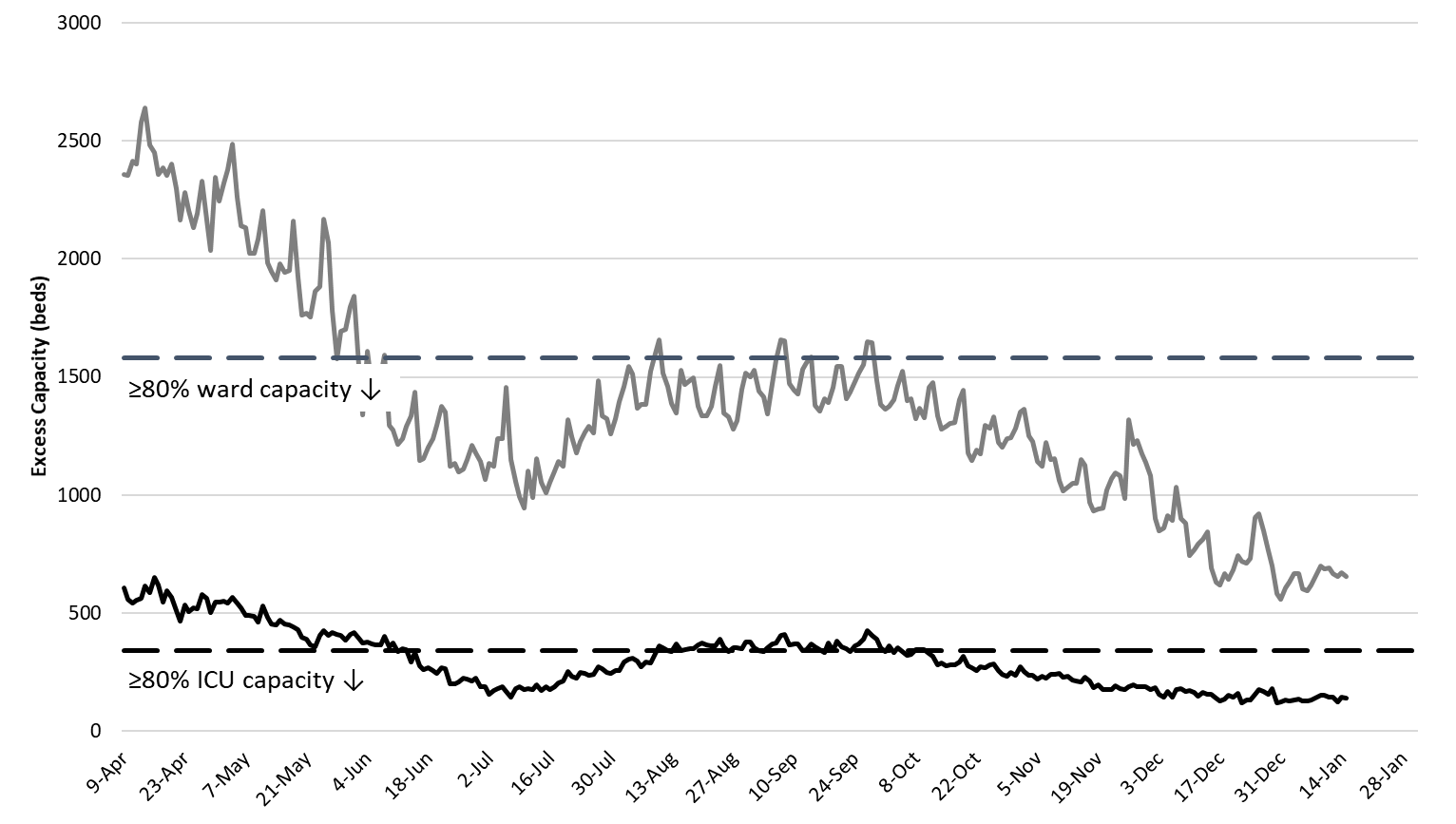
|
Figure 6. Observed Excess Non-Surge General Ward and ICU Capacity April 20 – January 15, 2021. |
The week ending December 20th has recorded 759 deaths, making it Arizona’s deadliest week so far (Figure 7). The tally for the week of December 20th will likely be surpassed by in the coming weeks as Covid-19 deaths are on track to exceed 700 per week (100 per day) for the foreseeable future. Tallies in excess of 800 deaths per week are likely in January.
Covid-19 deaths will also exceed 700 per week for the foreseeable future. The uniformly increasing mortality curve in Figure 7 should give us pause.
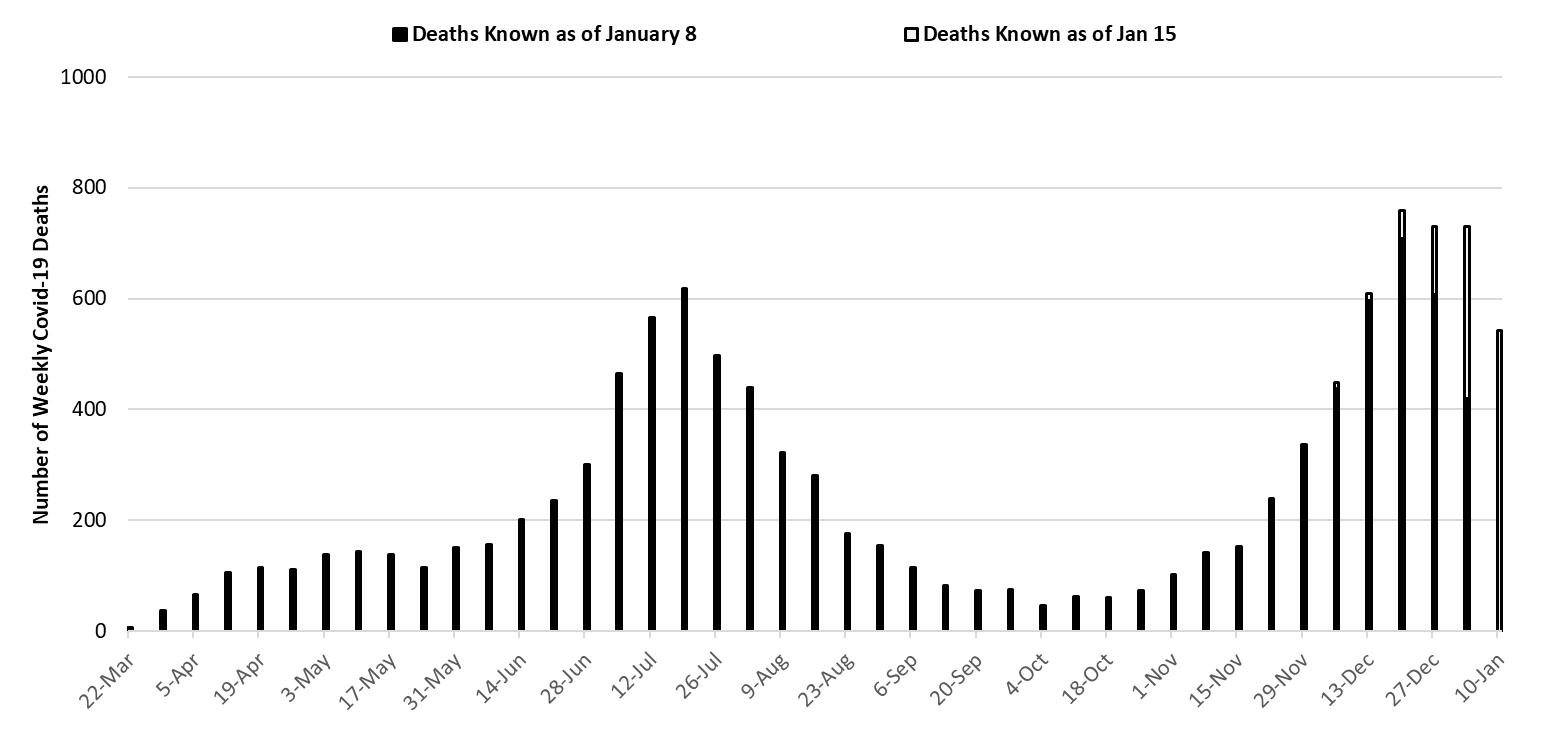
|
Figure 7. Weekly Arizona Covid-19 Deaths March 1 – January 10, 2021. |
Food for Thought
Using case counts to predict the course of the Covid-19 outbreak is intuitively obvious but statistically challenging. Case counts can provide misleading signals because of changes unrelated to viral transmission such as testing capacity, testing accuracy, testing uptake, and reporting delays. Figure 8, an accelerometer of week-over-week changes in the 7-day moving average of cases, illustrates this point. Until Thanksgiving, week-over-week changes tracked closely with long-term trends. Since Thanksgiving, week-over-week changes have oscillated widely making them much less useful barometer.
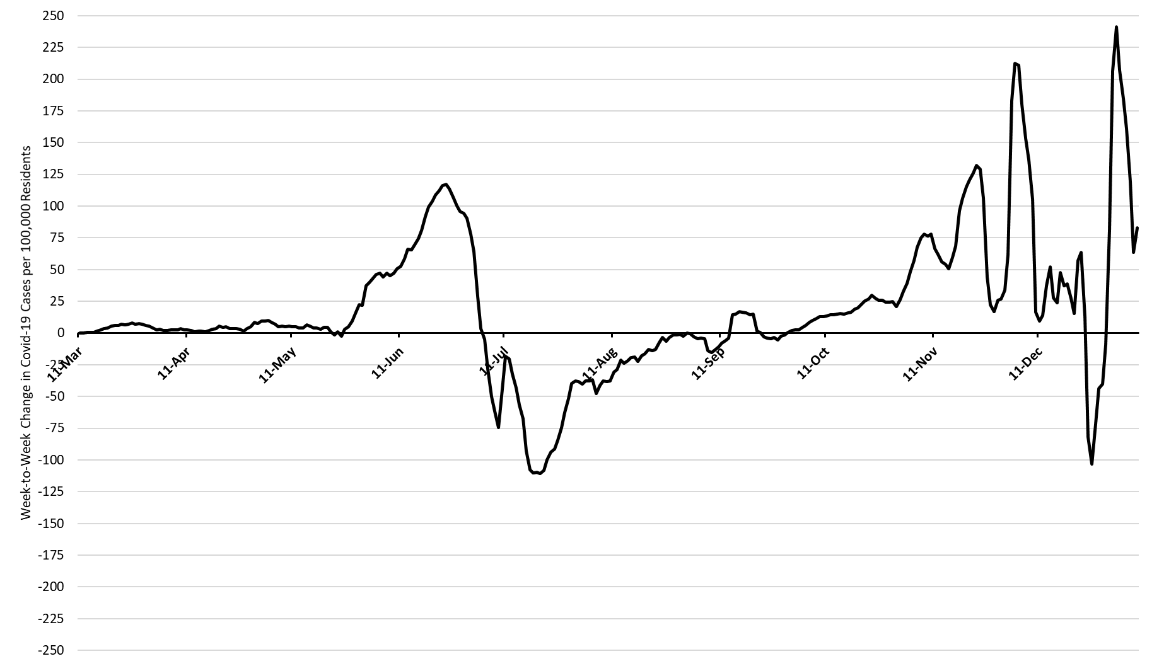
|
Figure 8. Week-over-Week Changes in 7-Day Moving Average of Covid-19 Cases March 1 – January 8, 2021. |
The second data item, I would like to revisit is serology testing. Earlier this summer, I discounted its usefulness due to sampling bias. However, given the breadth of this fall outbreak, I wanted to show them again (Figure 9). Serology positivity reached 36% this week establishing a likely upper bound on the percentage of Arizonans who have been infected. In September, an ASU-Maricopa County collaboration indicated 11% of Arizonans were seropositive leading to a 3.5X multiplier of reported cases to presumed cases. Given cumulative incidence is now 8900 cases per 100,000 residents, the multiplier would yield 31% seroprevalence. If these estimates are substantiated, they indicate we may be getting near the point at which natural immunity begins to act as a drag on the pace of viral transmission.
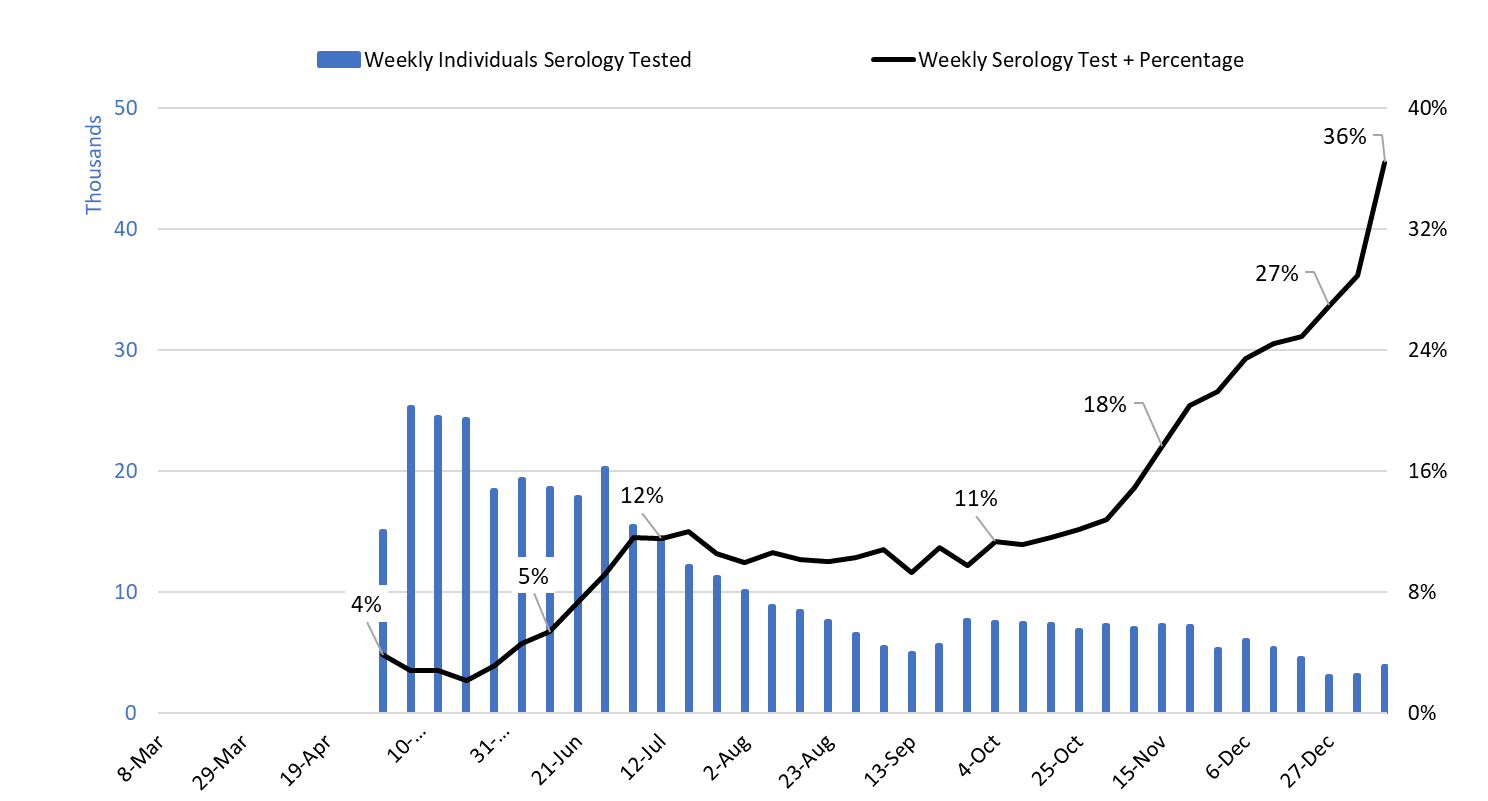
|
Figure 9. Number of Individuals undergoing Serology Testing and Weekly Test Positivity Mar 1 – January 10. |
Pima County Outlook
For the week ending January 10th, 8274 Pima County residents were diagnosed with Covid-19 (Figure 10). This represents an 11% increase from the 7470 cases initially reported last week and a new record. Test capacity and/or uptake has returned to mid-December levels. Last week’s initial tally of 7470 cases was upwardly revised by 2% (147 cases) this week.

|
Figure 10. Covid-19 Cases and Individuals Undergoing Diagnostic Testing in Pima County Mar 1 – Jan 10. |
Last week’s initial tally of 7470 cases was upwardly revised by 2% (147 cases) this week. Trends are similar across various age groups (Figure 11).
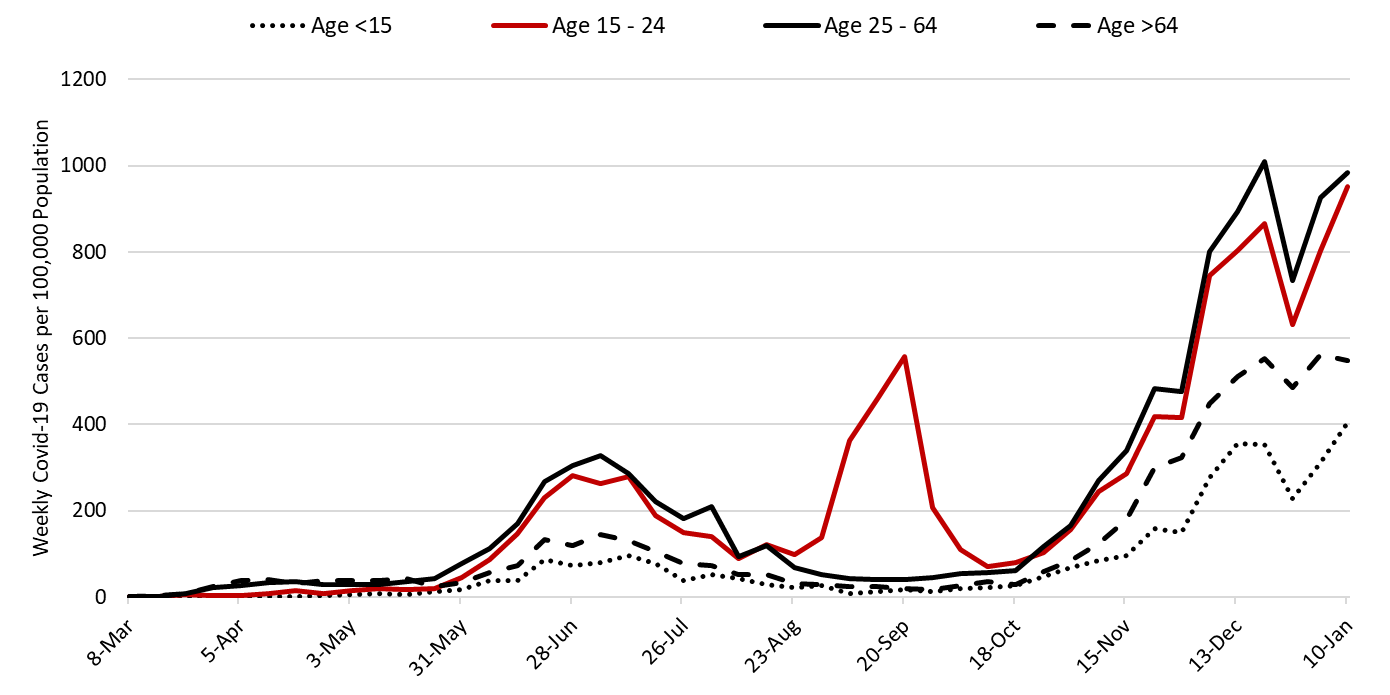
|
Figure 11. Covid-19 Cases by Age Group in Pima County from March 1 – January 10, 2021. |
Summary
- The SARS-CoV-2 virus continues to rampage through Arizona. Daily cases and fatalities could double, or perhaps quadruple, before declining under the weight of natural and/or vaccine-induced immunity later this winter. However, the arrival of a more transmissible UK variant could change this calculus for the worse. Arizona’s outbreak remains appallingly bad. A bit of good fortune (or preferably policy action) is needed to gain additional time to vaccinate Arizona’s most vulnerable citizens.
- As of January 8th, new cases were being diagnosed at a rate of 860 cases per 100,000 residents per week (Figure 11 below). This rate is increasing by approximately 83 cases per 100,000 residents per week. According to the CDC, no other state is currently experiencing faster spread transmission. Because of this, Arizona is now the 9th hardest hit state since the outbreak began.
- Arizona is reporting >700 Covid-19 deaths per week (>100 per day) and this count may underestimate true fatalities by half (see Woolf, Woolf, or Weinberger). Many of these deaths were preventable if the state had more aggressively adopted evidenced-based public health practices. Arizona weekly tally of deaths ranks second behind Alabama. Last week’s leader, Rhode Island, has since dropped to 12th.
- A state-wide shelter-in-place order, or at minimum, a resumption of the summer’s targeted business closures is still warranted to slow transmission and to mitigate overcrowding in our hospitals. A state-wide mask mandate is also warranted. Individuals and business who do not comply with restrictions should face sanctions.
- If such actions are taken, they must be accompanied by additional state funds to alleviate food insecurity, to prevent evictions and foreclosures, and to protect access to health services through the end of spring.
- Acknowledging that a shelter-in-place order is unlikely, counties should be granted additional authority to establish and enforce alternative Covid-19 mitigation policies.
- All Arizona residents should wear a mask in public, avoid social gatherings, maintain physical distance from non-household contacts, avoid >15 minutes contact in indoor spaces, especially if physical distancing is inadequate and adherence to face masks is low.
- Hospital Covid-19 occupancy has at least temporarily plateaued at record levels this week in the ward and ICU. However, some of this could be attributable to coping mechanisms that are hidden from view.
- Hospitals continue to postpone scheduled procedures to create additional capacity for Covid-19 patients at the expense of others with serious medical conditions. However, patients who would have been previously hospitalized are undoubtedly being treated in an outpatient setting.
- Health professionals are being asked to work additional hours and assume duties outside their traditional scope of practice. Shortages and burn-out will degrade our capacity to provide critical care services over the coming weeks.
- The test positivity rate for traditional nasopharyngeal PCR testing declined slightly this week, dropping from 35% to 33% positivity. This indicates viral transmission is growing more slowly than testing capacity is increasing. Nevertheless, our testing capacity is wholly inadequate to the scale of the problem and other regions.
Forecast reports to date, available as PDFs
Download PDF to view additional charts of Arizona counties, available in appendix of report.
2020 Reports
Based on what we know now about this pandemic, we support guidelines for social distancing to slow the spread of the virus and urge everyone to follow the recommendations provided by the Centers for Disease Control and Prevention (CDC) to protect yourself, your family, your neighbors, and your employees. Please heed the recommendations as provided by the CDC, found at the following website: https://www.cdc.gov/coronavirus/2019-ncov/prepare/prevention.html
COVID covid coronavirus virus covid19 corona forecast model

